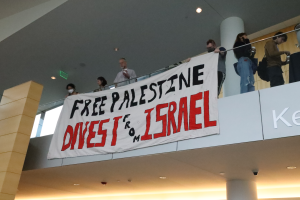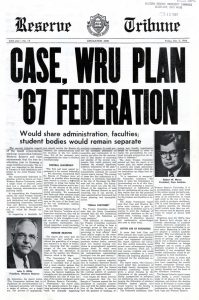Strosacker Auditorium was filled with curious undergraduate students on Tuesday, Oct. 30 when Case Western Reserve University president Barbara Snyder gave her annual State of the University address. The four main themes of the address were the increased freshman class and future class sizes, residence halls, information technology services (ITS), and CWRU’s strategic plan.
In opening, Snyder highlighted one of CWRU’s biggest accomplishments, the Class of 2016, noting that it was CWRU’s biggest and most diverse class yet. After showing a video of the class of 2016, Snyder noted that this milestone would not have been accomplished without the classes of 2013, 2014, and 2015. Snyder then dove into talking about students’ concerns.
One of the biggest concerns was how the huge increase in the size of the class of 2016 would affect future class sizes. Snyder said that the CWRU administration has created models of the courses expected to exceed capacity, and have, as a result, added more sections of those courses.
In addition, students wondered how the larger class size would affect student housing. Snyder said that this issue is slightly more complex, but that the university is looking to build more residence halls in the future.
In the short term, however, future class sizes will be managed. The ideal class size, Snyder said, would be between 1150 and 1250 students. CWRU is also working on giving the residence halls a facelift.
One of the other main topics that Snyder addressed was Information Technology Services. This year, 500 new wireless access points were added to both the North and South Residential Villages, increasing the number of access points to 2300.
Snyder also stressed the importance of these updates, considering that, for many prospective students, ITS is a significant factor in choosing which university to attend. She also noted that many students have more wireless devices in use than they have before, such as wireless gaming devices, smartphones, and tablets, which has increased the need to expand the wireless network on campus.
Another campus improvement that Snyder discussed concerns online learning. In the future, several degrees at CWRU will be offered online. The first online degree will be offered through the Mandel School of Applied Social Sciences’ graduate program.
MediaVision will also be more accessible to upperclassmen. Currently, mostly large, introductory level first-year classes are recorded on MediaVision. In the future, professors will be able to use MediaVision themselves if they wish to do so.
Snyder then addressed the new strategic plan for the next few years. She informed students that CWRU would develop new plans to increase excellence in teaching and advising. The faculty handbook has been updated, and the First-Year Advisory Council will work towards improved mentor-mentee relationshiBS, especially among the class of 2016.
In addition, Snyder emphasized that diversity and international opportunities will play a larger role in the future. She noted that this is already showing – both long- and short-term study abroad opportunities for students have increased. In addition, the Weatherhead School of Management has recently acquired new international partners.
Snyder stated, “We are not merely updating our strategic plan, but rethinking and shaping it for a better CWRU.”
After Snyder’s speech, students had the opportunity to ask her questions.
Student (S): What are the plans for the Morley Building?
Snyder (BS): The Morley Building is actually formally known as the Chemistry Building. We are not going to tear down the building, but we will renovate it to make it something truly terrific. The plans for the renovation are long-term, and not immediate.
S: With the completion of the Tinkham Veale University Center, what will happen to Thwing?
BS: Some organizations that are not currently in Thwing will move there. In the long-term, we are looking at taking down the atrium that connects the two main buildings of Thwing, because architects say that the atrium distorts the value of the buildings.
S: What is the status of the Think[box] building?
BS: The Think[box] building will be housed in the Lincoln Storage building. We have designed a plan to turn it in to a great innovation center. The building will have multiple floors with great equipment. We are currently raising money for the building, and it is going well, but we have a bit more fundraising to do. Once we are a bit further in fundraising, a more concrete timeline for the project will develop.
S: Students often say the price of the student meal plan does not match the value and the flexibility of the meal plan services provided on campus. Is there anything being done to fix this?
BS: We really do work hard to make sure the meal plan is being accepted in various places; however, we do want student feedback on this issue to know how we can make it more flexible. In addition, there is a food committee that works with Bon Appètit to make sure the food being served is what students desire.
S: Could you please elaborate on the development of West Campus?
BS: The West Campus will be at the site of the former Mount Sinai campus. It will hold a performing arts center and a medical education research building. The plan is to connect the north side of campus (near Kelvin Smith Library and the Cleveland Museum of Art) to West Campus via a bridge.
S: What initiatives does CWRU have to increase the number of minorities on campus?
BS: Well, we are very proud that the Class of 2016 is the most diverse class CWRU has ever had. In addition, CWRU has a diversity strategic plan that was implemented this fall. The plan has a number of steps to increase both the diversity of students, faculty, and staff. CWRU now publishes an annual report in January on the state of diversity.
S: There are often weather problems in Cleveland. How does CWRU deal with weather?
BS: There is a very well-defined process for dealing with weather. There is a team that includes the provost, campus security, and an emergency preparedness expert. They look closely at weather patterns and campus conditions, such as power outages and extreme flooding. If it is truly significant, and we try to make the best decisions that we can, then they will make the call as to whether the campus closes, because we do put student safety first.
In addition, we make our decisions solely based on our campus and location, and not other schools. Other schools might have a significant number of commuters, so they might shut down quicker than we do, for example. Also, although students might want class to be cancelled, often times it is better that there is class because some professors might want to schedule another class which may cause more inconveniences.
S: Some parts of the CWRU’s website are not up to date. Is there anything being done to fix this?
Response: (Answered by a representative from ITS and marketing department) Currently, CWRU has over 1200 servers, which make it very complex to accomplish website maintenance. We are trying to consolidate the servers, and will then begin a process to update all the information. We will start updating information in 2013, and it should take us approximately 18 months to finish the whole process.
S: The Huffington Post recently said CWRU was the “Most Ugly Campus.” What are your thoughts on this?
BS: I really do not know why they ranked us as such. The campus is really beautiful, and I felt terrible about that ranking. I am very proud of our campus.
S: A lot of people are having trouble with a specific class. These complaints are not based on the class rigor, but rather valid concerns about its structure. What can students do about this?
BS: Students should email the dean or the provost’s office, and not wait until class evaluations so that, if need be, changes can be made.
S: In some areas, specifically around Mather Quad, the campus is poorly lit. Is CWRU doing anything to change this?
BS: The construction of the University Center took out a lot of lights in that area, but we will talk to the facilities department and make sure there is enough lighting before winter. We will not wait on it.
















